 | | | Switch to: Europe, USA, New Zealand, Antarctica Credit: NOAA/Ovation  Planetary K-index Planetary K-index
Now: Kp= 1.00 quiet
24-hr max: Kp= 1.33 quiet
explanation | more data
Interplanetary Mag. Field
Btotal: 4.20 nT
Bz: 1.44 nT north
more data: ACE, DSCOVR
Updated: Today at 1146 UT  Coronal Holes: 17 May 23 Coronal Holes: 17 May 23 
There are no equatorial coronal holes on the Earthside of the sun. Credit: SDO/AIA  Noctilucent Clouds Noctilucent Clouds
Bad news: NASA's AIM spacecraft, which monitors noctilucent clouds, may be dead due to problems with an onboard battery. Mission controllers have not yet given up all hope, so stay tuned. Switch view:Ross Ice Shelf, Antarctic Peninsula, East Antarctica, Polar Updated May17  SPACE WEATHER
NOAA Forecasts | | Updated at: 2023 May 17 2200 UTC FLARE | 0-24 hr | 24-48 hr | CLASS M | 25 % | 25 % | CLASS X | 05 % | 05 % |  Geomagnetic Storms: Geomagnetic Storms:
Probabilities for significant disturbances in Earth's magnetic field are given for three activity levels: active, minor storm, severe storm Updated at: 2023 May 17 2200 UTC Mid-latitudes | 0-24 hr | 24-48 hr | ACTIVE | 10 % | 10 % | MINOR | 05 % | 01 % | SEVERE | 01 % | 01 % | High latitudes | 0-24 hr | 24-48 hr | ACTIVE | 15 % | 15 % | MINOR | 20 % | 20 % | SEVERE | 15 % | 10 % | | | |  | | | | | | | | | | | Never miss another geomagnetic storm. Sign up for Space Weather Alerts and you'll receive a text message when magnetic storms erupt. Aurora tour guides and professional astronomers use this service. You can, too! | | | EMERGING BIG SUNSPOT: The source of yesterday's partially-eclipsed X-flare is emerging into full view over the sun's southeastern limb. It is a large sunspot, some 3 times wider than Earth, and is surrounded by a bright froth of magnetic tubulence. Since the May 16th eruption, it has been relatively quiet--gathering strength for the next eruption? Stay tuned. Solar flare alerts: SMS Text. PARTIALLY ECLIPSED X-FLARE: Yesterday, May 16th, Earth-orbiting satellites detected an M9.6-class solar flare from a sunspot hiding behind the sun's southeastern limb. It was only percentage points away from being an X-flare. In fact, it probably was an X-flare partially eclipsed by the edge of the sun. 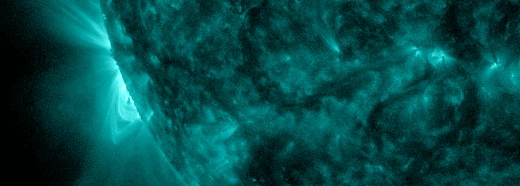
Although the underlying sunspot was hidden from view, it nevertheless managed to touch Earth. Radiation ionized the top of our planet's atmosphere, causing a deep shortwave radio blackout over North America: map. "I knew something significant was happening on the sun today when all the normal radio stations I monitor suddenly faded," reports amateur radio astronomer Thomas Ashcraft of New Mexico. His shortwave radio telescope recorded the broadband event: 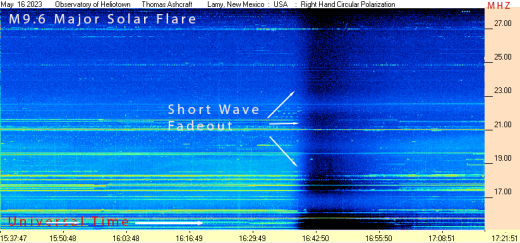
Horizontal lines in this dynamic spectrum are terrestrial radio stations. All of them sharply faded immediately after the flare. Loss of signal lasted 10 minutes at the top of the band (27 MHz) and more than 20 min at the bottom (16 MHz). This is typical of solar radio blackouts-- the lowest frequencies are hit hardest. The source of this explosion may be the same farside sunspot we discussed on May 12th. If so, it could emerge over the eastern limb later today, with solar rotation turning it almost directly toward Earth this weekend. Solar flare alerts: SMS Text. Realtime Aurora Photo Gallery
Free: Spaceweather.com Newsletter MR. SPOCK BEER COZY (BEER NOT INCLUDED): Father's Day is coming, and this is the gift every Trekkie Dad needs: the Mr. Spock beer cozy. The students of Earth to Sky Calculus launched it to the stratosphere onboard a cosmic ray research balloon: 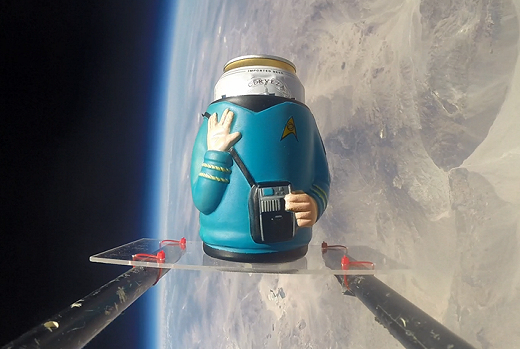
You can have it for $99.95. The students are selling beer cozies (beer not included) to support their cosmic ray ballooning program. They make great Father's Day and birthday gifts. Each one comes with greeting card showing the cozy in flight, and telling the story of its trip to the stratosphere and back again. Far Out Gifts: Earth to Sky Store
All sales support hands-on STEM education
Realtime Space Weather Photo Gallery
Free: Spaceweather.com Newsletter Every night, a network of NASA all-sky cameras scans the skies above the United States for meteoritic fireballs. Automated software maintained by NASA's Meteoroid Environment Office calculates their orbits, velocity, penetration depth in Earth's atmosphere and many other characteristics. Daily results are presented here on Spaceweather.com. On May 17, 2023, the network reported 20 fireballs.
(20 sporadics) 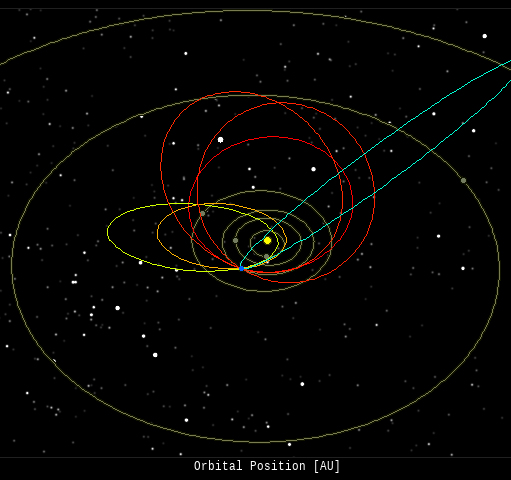 In this diagram of the inner solar system, all of the fireball orbits intersect at a single point--Earth. The orbits are color-coded by velocity, from slow (red) to fast (blue). [Larger image] [movies] Potentially Hazardous Asteroids ( PHAs) are space rocks larger than approximately 100m that can come closer to Earth than 0.05 AU. None of the known PHAs is on a collision course with our planet, although astronomers are finding new ones all the time. On May 17, 2023 there were 2316 potentially hazardous asteroids.
 | Recent & Upcoming Earth-asteroid encounters: | Asteroid | Date(UT) | Miss Distance | Velocity (km/s) | Diameter (m) | | 2023 JA3 | 2023-May-12 | 0.3 LD | 8 | 4 | | 2023 JJ2 | 2023-May-12 | 19.7 LD | 9.8 | 36 | | 2023 HT4 | 2023-May-12 | 15.9 LD | 8.9 | 79 | | 2023 JG2 | 2023-May-12 | 1.2 LD | 12.5 | 11 | | 2023 JD1 | 2023-May-13 | 7.8 LD | 6.7 | 19 | | 2023 JG | 2023-May-13 | 18.6 LD | 15.3 | 51 | | 2023 JN2 | 2023-May-13 | 1.4 LD | 20.2 | 14 | | 2023 JR1 | 2023-May-14 | 1 LD | 20.2 | 13 | | 2023 JP | 2023-May-14 | 8.4 LD | 7.8 | 27 | | 2023 JL1 | 2023-May-15 | 6.5 LD | 7.3 | 12 | | 2023 JO1 | 2023-May-16 | 7.8 LD | 8.3 | 15 | | 2023 JD2 | 2023-May-16 | 14.7 LD | 13 | 63 | | 2023 JS1 | 2023-May-17 | 5.7 LD | 8 | 12 | | 2023 JC3 | 2023-May-17 | 12.8 LD | 13.3 | 20 | | 2023 JT2 | 2023-May-17 | 6.9 LD | 4.5 | 10 | | 2023 JT4 | 2023-May-18 | 5.1 LD | 3.2 | 7 | | 2023 JW3 | 2023-May-18 | 8.4 LD | 8.1 | 27 | | 2011 KY15 | 2023-May-18 | 19.9 LD | 14.3 | 54 | | 2023 JS4 | 2023-May-18 | 16.2 LD | 13.8 | 38 | | 2023 JL2 | 2023-May-20 | 15.6 LD | 9.4 | 42 | | 2023 HG11 | 2023-May-20 | 11.8 LD | 0.4 | 7 | | 2023 JK | 2023-May-21 | 4.3 LD | 9.3 | 37 | | 2023 JD4 | 2023-May-21 | 8.1 LD | 10.3 | 37 | | 2021 JK7 | 2023-May-22 | 16.7 LD | 22.9 | 48 | | 2023 JK3 | 2023-May-22 | 1.6 LD | 4.9 | 26 | | 2023 GY2 | 2023-May-22 | 18.1 LD | 11.3 | 96 | | 2023 JZ1 | 2023-May-22 | 10.7 LD | 13 | 37 | | 2019 UJ3 | 2023-May-23 | 15.5 LD | 9.8 | 21 | | 2023 JK1 | 2023-May-23 | 17.1 LD | 8.7 | 37 | | 2023 JC4 | 2023-May-24 | 17.7 LD | 4.2 | 30 | | 2023 CL3 | 2023-May-24 | 18.9 LD | 7.3 | 117 | | 2023 JP2 | 2023-May-25 | 11.5 LD | 20.5 | 87 | | 2023 JR4 | 2023-May-25 | 4.1 LD | 9.4 | 14 | | 2023 JE2 | 2023-May-27 | 19.7 LD | 11.4 | 36 | | 2023 JZ3 | 2023-May-28 | 14.2 LD | 4.1 | 25 | | 2021 KO2 | 2023-May-29 | 15.8 LD | 13.9 | 9 | | 2012 KP24 | 2023-May-31 | 10.3 LD | 12.4 | 19 | | 2023 JM1 | 2023-Jun-01 | 10.1 LD | 5.2 | 21 | | 2023 JR2 | 2023-Jun-04 | 17 LD | 7.6 | 44 | | 2018 KR | 2023-Jun-07 | 6.5 LD | 4.9 | 19 | | 2017 UJ2 | 2023-Jun-07 | 5.3 LD | 5.6 | 2 | | 2023 JB3 | 2023-Jun-09 | 14.1 LD | 7 | 47 | | 488453 | 2023-Jun-12 | 8.3 LD | 21.5 | 495 | | 2022 WN4 | 2023-Jun-13 | 10.8 LD | 15.1 | 158 | | 2020 DB5 | 2023-Jun-15 | 11.3 LD | 9.5 | 506 | | 2023 HL | 2023-Jun-17 | 13.5 LD | 1 | 15 | | 2016 LK49 | 2023-Jun-19 | 17.4 LD | 19.4 | 22 | | 2018 LN2 | 2023-Jun-20 | 19 LD | 9.9 | 84 | | 2023 HF1 | 2023-Jun-21 | 12.5 LD | 4.4 | 59 | | 467336 | 2023-Jun-24 | 17.4 LD | 7.1 | 269 | | 2008 LG2 | 2023-Jun-24 | 10.5 LD | 5.6 | 32 | | 2022 MM1 | 2023-Jun-29 | 9.5 LD | 9.8 | 41 | | 2020 NC | 2023-Jul-02 | 13.9 LD | 7.7 | 123 | | 2023 HO6 | 2023-Jul-05 | 5.3 LD | 7.8 | 234 | | 2019 LH5 | 2023-Jul-07 | 14.9 LD | 21.6 | 281 | | 2018 NW | 2023-Jul-10 | 18 LD | 21.8 | 10 | | 2018 UY | 2023-Jul-12 | 7.4 LD | 16.4 | 243 | Notes: LD means "Lunar Distance." 1 LD = 384,401 km, the distance between Earth and the Moon. 1 LD also equals 0.00256 AU. | | Cosmic Rays in the Atmosphere | SPACE WEATHER BALLOON DATA: Almost once a week, Spaceweather.com and the students of Earth to Sky Calculus fly space weather balloons to the stratosphere over California. These balloons are equipped with sensors that detect secondary cosmic rays, a form of radiation from space that can penetrate all the way down to Earth's surface. Our monitoring program has been underway without interruption for 7 years, resulting in a unique dataset of in situ atmospheric measurements. Latest results (July 2022): Atmospheric radiation is decreasing in 2022. Our latest measurements in July 2022 registered a 6-year low: 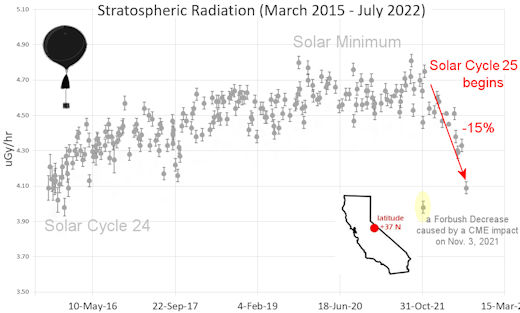
What's going on? Ironically, the radiation drop is caused by increasing solar activity. Solar Cycle 25 has roared to life faster than forecasters expected. The sun's strengthening and increasingly tangled magnetic field repels cosmic rays from deep space. In addition, solar coronal mass ejections (CMEs) sweep aside cosmic rays, causing sharp reductions called "Forbush Decreases." The two effects blend together to bring daily radiation levels down. .Who cares? Cosmic rays are a surprisingly "down to Earth" form of space weather. They can alter the chemistry of the atmosphere, trigger lightning, and penetrate commercial airplanes. According to a study from the Harvard T.H. Chan school of public health, crews of aircraft have higher rates of cancer than the general population. The researchers listed cosmic rays, irregular sleep habits, and chemical contaminants as leading risk factors. A number of controversial studies (#1, #2, #3, #4) go even further, linking cosmic rays with cardiac arrhythmias and sudden cardiac death. Technical notes: The radiation sensors onboard our helium balloons detect X-rays and gamma-rays in the energy range 10 keV to 20 MeV. These energies span the range of medical X-ray machines and airport security scanners. Data points in the graph labeled "Stratospheric Radiation" correspond to the peak of the Regener-Pfotzer maximum, which lies about 67,000 feet above central California. When cosmic rays crash into Earth's atmosphere, they produce a spray of secondary particles that is most intense at the entrance to the stratosphere. Physicists Eric Regener and Georg Pfotzer discovered the maximum using balloons in the 1930s and it is what we are measuring today. | | The official U.S. government space weather bureau | | | The first place to look for information about sundogs, pillars, rainbows and related phenomena. | | | Researchers call it a "Hubble for the sun." SDO is the most advanced solar observatory ever. | | | 3D views of the sun from NASA's Solar and Terrestrial Relations Observatory | | | Realtime and archival images of the Sun from SOHO. | | | information about sunspots based on the latest NOAA/USAF Active Region Summary | | | current counts of failed and deployed Starlink satellites from Jonathan's Space Page | | | Authoritative predictions of space junk and satellite re-entries | | | from the NOAA Space Environment Center | | | fun to read, but should be taken with a grain of salt! Forecasts looking ahead more than a few days are often wrong. | | | from the NOAA Space Environment Center | | | the underlying science of space weather |  | Getting YouTube comments is essential if you want to beat the algorithm! That’s why you need to buy YouTube comments from RealSocialz.com because they offer real USA comments you can customize. |  | BestCSGOGambling is the best site for everything related to CSGO gambling on the web |  | Looking for sports betting companies not registered on GamStop? CasinoGap has presented a list of sites not on GamStop available for UK players. Check and bet online! Would you like to bet at sites not using GamStop? Look at a list of NonStopCasino sites for online betting that aren't on GamStop. Top-rated bookmakers ever! | | | These links help Spaceweather.com stay online. Thank you to our supporters! | | | | | | | | |  | |  |   | ©2021 Spaceweather.com. All rights reserved. This site is penned daily by Dr. Tony Phillips. | |

